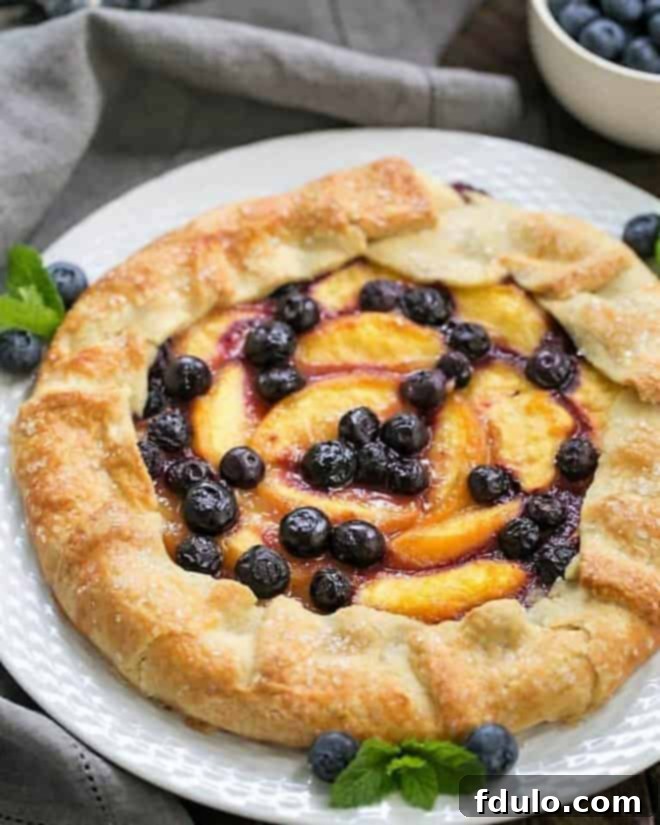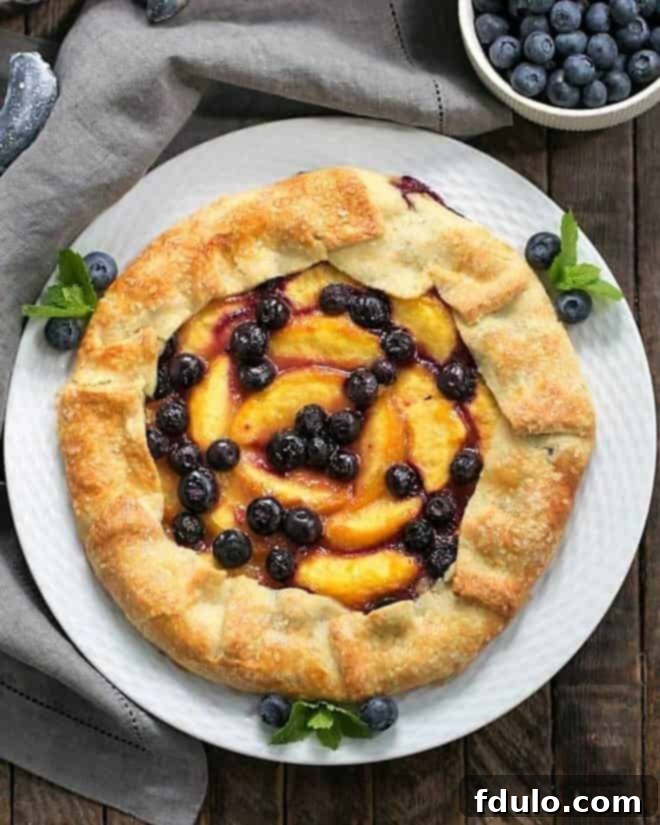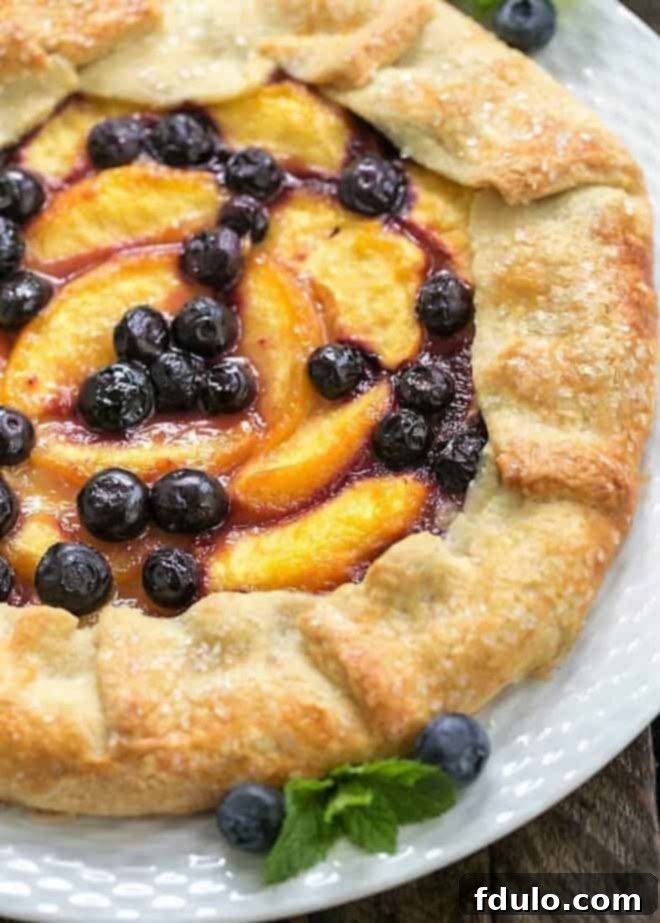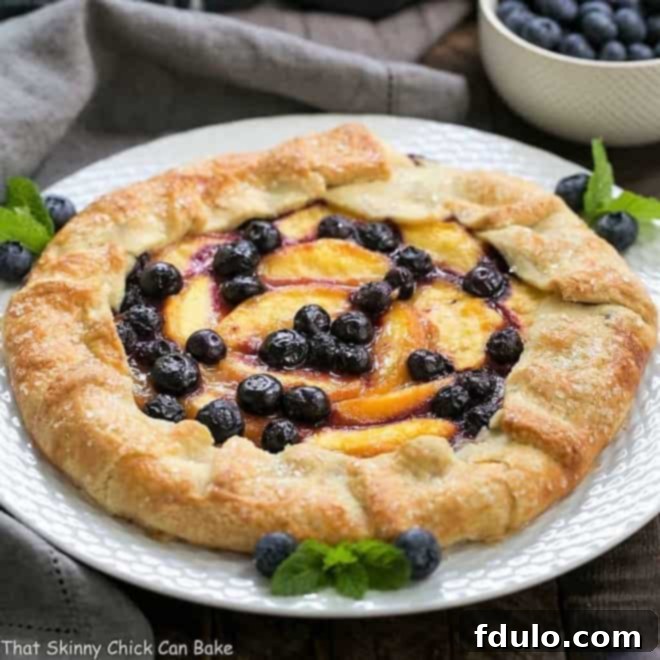There’s a special joy in baking, particularly when it results in a dessert that captures the essence of summer with minimal effort. For many, the thought of creating a perfect pie crust can be daunting, a culinary challenge often met with frustration. But what if you could enjoy all the incredible flavors of a homemade pie – the tender fruit, the buttery crust – without the stress of intricate crimping, blind baking, or the dreaded “soggy bottom”? Enter the magnificent Peach Blueberry Galette, a rustic masterpiece that promises exquisite taste and a wonderfully relaxed baking experience. This free-form tart is a game-changer for anyone who loves pie but not the elaborate process. It’s simple, elegant, and bursts with the vibrant flavors of peak-season fruit, making it an ideal choice for any summer gathering or a delightful treat at home.

Why This Peach Blueberry Galette Is Your Ultimate Summer Dessert Solution
My personal journey with pie crusts has been a saga of triumphs and tribulations. While I deeply appreciate the flaky, buttery goodness of a well-made crust, the precision required for fluting, weaving intricate lattice tops, or achieving that picture-perfect double crust can often transform a joyful baking session into a high-pressure culinary event. This inherent “love-hate relationship” with traditional pie-making is precisely why the Peach Blueberry Galette has become my beloved culinary savior, especially during the sun-drenched months. It offers a liberating alternative to the complexities of classic pies, delivering all the fantastic, comforting flavors with a wonderfully rustic charm that demands no specialized techniques or exhaustive efforts.
- Effortless Elegance Redefined: Bid farewell to the anxieties of achieving an impeccably shaped pie. Galettes, by their very nature, embrace and celebrate imperfection. Their enchanting free-form design makes them astonishingly simple to assemble. The process is straightforward: you merely roll out a single crust, artfully arrange your chosen fruits, and then casually fold the edges inwards. There’s no cumbersome pie dish required, nor any complex decorating techniques needed. It stands as the quintessential choice when you aspire to present a beautiful, impressive dessert without committing countless hours to kitchen duty, making it utterly perfect for those long, humid summer days when your precious time is better spent savoring outdoor leisure.
- A Canvas of Unmatched Versatility: The inherent beauty of a galette resides significantly in its remarkable adaptability. While this particular recipe gloriously highlights the quintessential pairing of sweet peaches and tart blueberries, the spectrum of possibilities for fillings is genuinely boundless. I’ve personally experimented with a myriad of fruit combinations, ranging from a vibrant medley of mixed berries and crisp, juicy apples to luscious peaches intertwined with raspberries, and even ventured into savory realms featuring a delightful blend of rich cheese and sun-ripened tomatoes. It serves as an exceptional culinary canvas, eagerly awaiting whatever seasonal bounty you have readily available, thereby facilitating an endless array of creative permutations throughout the entire year.
- Celebrating Seasonal Perfection: The arrival of summer ushers in an abundant harvest of ripe, incredibly juicy fruits, and the galette stands as the supreme culinary vessel to eloquently showcase their inherent natural sweetness. When local peaches reach their peak of succulence and blueberries burst with concentrated flavor, crafting a galette allows their vibrant, unadulterated tastes to truly shine through. They are not overshadowed by an overly heavy crust or an excessive application of sugar. It’s a wonderfully light, refreshingly fresh, and profoundly satisfying dessert that acts as the perfect culinary accompaniment to any festive summer gathering, or simply as a serene, delightful treat for a quiet evening at home.
- Empowering Beginner Bakers: For those who are new to the captivating world of baking, or perhaps feel a touch intimidated by the perceived complexities of traditional pies, a galette emerges as your ideal entry point. The inherently forgiving nature of its crust, coupled with the utterly straightforward assembly process, positions it as an exceptionally accessible recipe for aspiring bakers of all skill levels. Engaging with this recipe will not only build your confidence in handling pastry dough but will also invariably lead to deliciously rewarding results that are certain to ignite a deeper passion for baking within you.
Glowing Endorsements from Our Enthusiastic Baking Community
You don’t just have to take my word for it! The widespread popularity and success of this particular galette recipe speak volumes about its undeniable appeal and deliciousness. Here’s what some delighted home bakers have enthusiastically shared about their wonderful experience crafting and savoring this exceptional dessert:
From Melisa: “I tried it! It came out…absolutely perfect!!! Best tasting crust that I have ever made and so easy to put together. I served it with vanilla bean ice cream. All gone no leftovers.”
From Debi: “This was an easy recipe and so delicious! The crust was perfect and flaky. Better than pie crust. Love it with vanilla ice cream as well!”
From Pinterest: “Everyone’s ravings about this recipe and especially the crust? True, true, true!! Excellent! Followed to a T and received lots of compliments. I usually make my own crusts, but so glad I didn’t on this. Delicious!”

Mastering Your Galette: Expert Tips for a Flawless and Flavorful Creation
Creating a truly spectacular Peach Blueberry Galette is far simpler than you might envision, especially when you empower yourself with a few fundamental insights and clever techniques. My profound passion for fresh, incredibly juicy summer peaches knows no bounds; they typically grace our markets, arriving from the sun-drenched orchards of Georgia and South Carolina, starting in early July. This heralded arrival perfectly sets the stage for a delightful succession of peach-infused desserts that span through early September. Among these seasonal delights, an easy peach blueberry galette consistently stands out as an outstanding choice. These expert tips are meticulously curated to guarantee your resounding success in the kitchen:
- Selecting Peak-Season Fruit for Optimal Flavor: The inherent quality and ripeness of your fruit will profoundly impact the final flavor profile and texture of your galette. Always make it a priority to source local produce whenever circumstances permit. Local fruits are generally harvested at their absolute peak of ripeness and have not endured the lengthy, flavor-diminishing process of interstate transportation. For peaches, look for a vibrant, blushing color, a gently fuzzy skin devoid of any green undertones, and a rich, sweet aroma that hints at their succulence. A slight, yielding give when gently squeezed indicates perfect ripeness. Similarly, blueberries should be plump, firm, and possess a powdery bloom.
- The Crucial Role of Cold Butter in Pastry: For a truly flaky, tender, and irresistible crust, the cardinal rule is to always use very cold butter, meticulously cut into small, uniform pieces. I personally find that using salted butter imparts an additional layer of flavor depth to the crust, but if your preference is unsalted butter, remember to proactively incorporate a small pinch of fine salt into your galette dough. This subtle addition will significantly enhance the overall taste balance. The principle here is that the cold butter, when it encounters the heat of the oven, creates distinct pockets of steam, which are instrumental in producing those coveted, ethereal flaky layers in your pastry.
- Embracing Convenience: Homemade or Store-Bought Crust: While my meticulously developed pastry recipe is specifically crafted to be exceptionally easy to roll out into a perfectly round shape, please do not hesitate to embrace the convenience of a high-quality store-bought crust for an even swifter shortcut. Many excellent refrigerated pie crusts are readily available on the market and perform admirably for galettes, thereby preserving your valuable time without any discernible compromise on deliciousness. The ultimate objective is to achieve a delectable dessert, and sometimes, the most expedient path to that goal is through thoughtful convenience.
- Mastering the Art of Rolling Dough Effortlessly: When embarking on the task of rolling out your dough, a lightly floured work surface and a lightly floured rolling pin are undeniably your most trusted allies. To expertly achieve a uniformly round 12-inch disk, initiate the process by rolling the pin over the dough, then rotate the dough approximately 45 degrees, and meticulously repeat this rolling and rotating sequence. This methodical rotation technique is exceptionally effective in preventing the dough from adhering to the surface and simultaneously ensures a consistent thickness and a beautifully even shape. Should your dough begin to feel overly warm or become sticky during this process, simply return it to the refrigerator for a brief 10-15 minute chill to allow it to firm up again.
- Ensuring a Non-Stick Experience with Parchment Paper: While parchment paper is an invaluable tool universally lauded for its non-stick properties, certain brands (particularly those lacking a subtle sheen) can still present a minor challenge when dealing with exceptionally juicy fruit fillings. For an added layer of assurance, a delicate spray of baking spray (such as Pam or Baker’s Joy) onto your parchment paper can make a remarkable difference. This simple step virtually guarantees that your magnificent galette will glide effortlessly off the sheet after baking, preserving its structural integrity and aesthetic appeal.
- Proactively Combatting the Dreaded Soggy Bottom: To effectively prevent the bottom crust of your galette from becoming undesirably soggy, especially when utilizing very juicy fruits, you can employ a clever preventive measure. Sprinkle a thin, even layer of an absorbent ingredient—such as fine bread crumbs, finely crushed cornflakes, ground almonds, or semolina flour—over the base of the dough before you meticulously arrange the fruit filling. These ingenious ingredients act as a protective barrier, diligently absorbing any surplus moisture released by the fruit during the baking process, thereby preserving the wonderfully crisp and firm texture of your crust.
Crafting Your Perfect Peach Blueberry Galette: A Detailed Step-by-Step Guide
Embarking on the creation of this rustic fruit tart is an unexpectedly straightforward endeavor, effortlessly transforming a handful of fresh, seasonal ingredients into a truly magnificent, show-stopping dessert. By diligently following these clear, concise steps, you are guaranteed a delightful and rewarding baking experience:
- Step 1: Prepare the Flaky Dough. Begin by combining 1 ½ cups of all-purpose flour, 1 tablespoon of granulated sugar, and ¼ teaspoon of salt in the bowl of a food processor. Pulse these dry ingredients briefly until they are thoroughly mixed. Next, add 11 tablespoons of very cold butter, which you’ve previously cut into ½ tablespoon pieces, into the food processor. Pulse the mixture in short bursts until the butter is broken down into small, pea-sized pieces, and the overall consistency resembles coarse cornmeal. In a separate small bowl, whisk together 1 egg yolk with 3 tablespoons of cold milk. Add this liquid mixture to the food processor and pulse just until the dough barely comes together into a cohesive mass. Turn the dough out onto a piece of plastic wrap, gently press it into a flat, round disk, wrap it tightly, and refrigerate for a minimum of 30 minutes. This crucial chilling period is vital for making the dough easier to handle and ensuring a tender, flaky crust.
- Step 2: Preheat Oven and Prepare Baking Sheet. While your dough is chilling in the refrigerator, preheat your oven to 350°F (175°C). Line a large, rimmed baking sheet with a sheet of parchment paper. This simple step is indispensable for preventing the galette from sticking and will make the transfer process and subsequent clean-up incredibly effortless.
- Step 3: Prepare the Luscious Fruit Filling. In a generously sized mixing bowl, gently combine 2 cups of peeled and thinly sliced fresh peaches with ½ cup of fresh blueberries. Add ¼ cup of granulated sugar, 2 tablespoons of all-purpose flour, and a tiny pinch of salt to the fruit. Carefully toss these ingredients together until the fruit is evenly coated. The added flour plays a critical role here, as it helps to thicken the natural juices released by the fruit during baking, thereby preventing the filling from becoming overly runny and maintaining the structural integrity of your galette.
- Step 4: Roll Out and Position the Dough. On a lightly floured clean work surface, take your thoroughly chilled dough and roll it out evenly into a large, approximately 12-inch diameter round. PRO-Tip for Perfect Circles: If you desire a perfectly symmetrical crust, you can employ a large, 12-inch diameter mixing bowl or a dinner plate as a template. Simply place it over your rolled-out dough and use a sharp knife to carefully trim around its edge, discarding any excess dough scraps. Once rolled, meticulously transfer the dough round to your prepared baking sheet.
- Step 5: Artfully Assemble the Galette. Evenly distribute the prepared peach and blueberry mixture over the center of the dough round. It is absolutely crucial to leave a clean, unobstructed border of about 1 to 1½ inches from the very edge of the dough. This unadorned margin is fundamental for the subsequent folding step and helps create a visual frame for your beautiful fruit.
- Step 6: Fold the Edges and Seal the Juices. With great care, begin to fold the exposed outer edge of the dough inward, over the fruit filling. Work your way methodically around the entire perimeter of the galette. As you do so, gently pleat the dough as needed; these natural pleats contribute to the charmingly rustic aesthetic and are essential for creating a contained border that will diligently hold in all the delectable fruit juices as your galette bakes.
- Step 7: Glaze for Golden Perfection. In a small bowl, lightly beat the reserved egg white until it’s slightly frothy. Using a pastry brush, generously brush this egg white mixture evenly over the entire exposed crust of the galette. This application will bestow a beautiful, glossy golden sheen upon your crust once baked. For an exquisite final touch of sweetness and an appealing sparkle, generously sprinkle both the egg-washed crust and the visible fruit filling with 2 tablespoons of coarse sugar (granulated sugar can be substituted if coarse sugar is unavailable).
- Step 8: Bake to Irresistible Perfection. Carefully slide the baking sheet into your preheated oven. Allow the galette to bake for approximately 50 minutes, or until the pastry crust achieves a magnificent golden-brown hue and the fruit filling is visibly bubbly, tender, and releases an intoxicating aroma. The irresistible fragrance that will soon permeate your kitchen is an infallible sign of impending deliciousness!
- Step 9: Cool, Slice, and Savor. Once baked, carefully remove the galette from the oven and allow it to cool on the baking sheet for at least 10-15 minutes before you attempt to slice it. This crucial cooling period allows the fruit juices to set and slightly thicken, ensuring clean slices. Serve individual slices warm or at a pleasant room temperature, perhaps exquisitely complemented by a luxurious dollop of sweetened whipped cream or a generous scoop of creamy vanilla bean ice cream for an extra layer of indulgent delight.
Requiring merely three perfectly ripe peaches and a modest half-cup of vibrant blueberries, and effortlessly brought to life with a crust that truly is a dream to roll out, this peach blueberry galette effortlessly claimed its title as an instant culinary triumph. My devoted husband, Bill, couldn’t resist the temptation, enthusiastically going back for seconds immediately after dinner – an irrefutable testament to its utterly irresistible flavor and charm! Indeed, it’s that exceptionally tasty, offering a harmonious and perfect symphony of sweet, tart, and sumptuously buttery goodness in every single, memorable bite.

Frequently Asked Questions About This Delightful Galette Dessert
At its very essence, a galette is a wonderfully rustic, free-form tart that typically features a single, round pastry crust artfully folded over a delectable filling. Originating from the diverse culinary regions of France, where a multitude of regional variations exist, the term “galette” broadly encompasses any round, relatively flat cake made from flaky pastry dough, yeast dough, or occasionally, unleavened dough. Its widespread popularity stems from its charming simplicity and remarkable versatility. Unlike a traditional pie, which necessitates baking in a specific dish, a galette is thoughtfully assembled directly onto a baking sheet. Its edges are then casually folded inward, creating a beautiful, organic frame that perfectly showcases the vibrant filling within. This method not only simplifies the baking process but also imparts a homemade, unpretentious elegance that is universally appealing.
The primary and most significant distinction between a galette and a crostata lies solely in their geographical nomenclature. “Galette” is the refined French term used to describe this rustic, open-faced tart, while “Crostata” serves as its equally delightful Italian counterpart. Fundamentally, both terms refer to precisely the same wonderful dessert concept: a free-form, single-crust pastry generously filled with a medley of fruits, rich jams, or an array of other sweet (and sometimes savory) ingredients, with its charming edges gracefully folded inward. Therefore, regardless of whether you choose to call it a galette or a crostata, you are essentially referring to the same wonderfully unfussy, effortlessly elegant, and undeniably delicious baked treat!
Shaping a galette is arguably one of its most forgiving and creatively satisfying steps, primarily because absolute perfection is neither the expectation nor the goal – rather, it is the celebration of rustic charm! After you have expertly rolled your pastry dough into a harmonious round (typically measuring between 10 to 12 inches in diameter), you will then carefully place your chosen fruit or other filling (which could range from sweet jams and crunchy nuts to savory meats and artisanal cheeses) directly in the center of the dough. The crucial element here is to ensure a substantial border of plain, uncovered crust, usually spanning about 1 to 1½ inches, around the entire perimeter. Subsequently, in a graceful motion, working your way meticulously around the circle, you will gently fold this outer edge of the crust over the filling. As you do so, you will naturally create soft pleats; these not only contribute to its endearing imperfect aesthetic but are also instrumental in creating a secure barrier that adeptly contains all the luscious juices as the galette bakes. The central portion of the galette remains elegantly open, allowing the vibrant and enticing filling to be prominently showcased.
Preventing an undesirable soggy bottom is a very common and understandable concern when baking fruit tarts, but fortunately, there are several highly effective strategies you can employ to ensure your galette remains delightfully crisp. Firstly, it is paramount to ensure that your dough is both properly chilled before use and subsequently baked at the precise, recommended temperature. This allows the crust ample opportunity to crisp up and develop its golden texture. Secondly, a highly effective technique involves sprinkling a thin, even layer of an absorbent ingredient—such as fine bread crumbs, finely crushed cornflakes, ground almonds, or semolina flour—over the bottom crust before you carefully add your fruit filling. These ingredients act as an invaluable moisture barrier, diligently soaking up any excess liquid released by the fruit during the baking process. Additionally, incorporating a small quantity of flour (as specified in this recipe) or cornstarch directly with your fruit mixture significantly aids in thickening the juices, further mitigating sogginess. Finally, for optimal crispness, it is best to serve your galette within one or two days of baking. If you need to reheat it, do so gently in the oven. Storing it uncovered or very loosely covered at room temperature for the first day can also help prevent moisture buildup.
A galette boasts an incredible versatility in its serving potential, rendering it an impeccable choice for a diverse array of occasions. It is absolutely divine when served warm, directly from the oven, allowing the rich, buttery crust and the tender, caramelized fruit filling to truly express their peak flavors. However, it is equally enchanting when served at a pleasant room temperature, which makes it an exceptional dessert for entertaining, as it elegantly sidesteps the need for any last-minute kitchen fuss. For sweet dessert galettes, enhancing the experience by cutting them into generous wedges and offering luxurious accompaniments such as a generous scoop of premium vanilla bean ice cream, a dollop of freshly sweetened whipped cream, or a delicate drizzle of tangy crème fraîche will elevate the dessert to new heights. Conversely, savory galettes are wonderfully suited as sophisticated appetizers, light and satisfying lunches, or as an intriguing side dish. Generally, a sweet fruit galette will maintain its quality and appeal when stored at room temperature for approximately two days. However, savory versions containing ingredients like meat or cheese should be promptly refrigerated and consumed within a shorter timeframe for safety and freshness.
Indeed, galettes lend themselves exceptionally well to freezing, positioning them as a fantastic and convenient make-ahead option for busy schedules! To successfully freeze a baked galette, first ensure it has completely cooled down to room temperature. Once cool, meticulously wrap it in several layers of plastic wrap, followed by a robust layer of aluminum foil, ensuring the entire package is as airtight as possible. This meticulous wrapping process is crucial for preventing freezer burn and safeguarding its delicate flavor and appealing texture. A galette that has been properly wrapped and frozen can be stored in the freezer for an impressive duration of up to three months. When you are ready to serve, simply transfer the frozen galette to the refrigerator and allow it to defrost overnight. Once thawed, you can gently reheat it in a preheated oven (set to approximately 300-325°F or 150-160°C) for about 15-20 minutes, or until it is thoroughly warmed through, which helps to revive some of its freshly baked crispness. Alternatively, you can also freeze an unbaked galette: assemble it fully, then freeze it solid directly on the baking sheet before wrapping it tightly. If baking from frozen, you will need to add extra baking time to the recipe.
You May Also Like: Other Irresistible Dessert Inspirations
- No Churn Strawberry Cheesecake Ice Cream from Big Bear’s Wife
- Fresh Raspberry Crisp
- Peach Blueberry Cobbler
- Razzleberry Pie
- Easy Rhubarb Crisp
- Cheesecake Ice Cream
- Best Summer Dessert Recipes
- More Dessert Recipes
We absolutely adore hearing from our wonderful baking community! Stay actively connected and generously share your delightful baking adventures with us across all our social media platforms: Instagram, Facebook, and Pinterest. And, most importantly, please don’t ever forget to tag me when you proudly try one of my cherished recipes! If you thoroughly enjoyed crafting and savoring this delightful Peach Blueberry Galette, we would be incredibly grateful if you would consider leaving a glowing 5-star rating and a heartfelt comment directly on the blog to let us and other aspiring bakers know about your fantastic experience. Your invaluable feedback plays a crucial role in helping countless other bakers discover and wholeheartedly enjoy these delectable recipes too!
Peach Blueberry Galette
A scrumptious dessert featuring peaches and blueberries and a buttery pastry crust!

30 minutes
50 minutes
1 hour 20 minutes
6 servings
Ingredients
Crust:
- 1 ½ cups flour, plus more for rolling
- 1 tablespoon sugar
- ¼ teaspoon salt
- 11 tablespoons cold butter, cut into ½ tablespoon pieces, I used Land o’ Lakes
- 1 egg yolk (reserved white to glaze dough)
- 3 tablespoons milk
Filling:
- 2 cups peeled and sliced fresh peaches (about 1 pound)
- ½ cup fresh blueberries
- ¼ cup sugar
- 2 tablespoons flour
- Pinch of salt
- 1 egg white, beaten
- 2 tablespoons sugar (coarse sugar preferred but granulated is fine)
Instructions
- To make the dough, combine the flour, sugar, and salt in a food processor and pulse to combine. Add the butter to the flour and pulse till the butter is broken into small pieces and the mixture resembles cornmeal.
- Mix together the egg yolk and milk and add to the dough. Pulse till the dough comes together. Pour onto a piece of plastic wrap and press into a flat disk. Wrap and chill for 30 minutes.
- Preheat the oven to 350°F. Line a rimmed baking sheet with parchment paper and set aside.
- Carefully toss the peaches and blueberries with the sugar, flour, and salt.
- Roll out the dough to a 12-inch round on a lightly floured surface. Carefully move the dough to the baking sheet. Arrange the fruit in the center of the dough, leaving about an inch of the perimeter uncovered.
- Fold the outside edge of the dough over the fruit, pleating as needed. Brush egg white over the exposed crust. Sprinkle the coarse sugar over the dough and fruit.
- Bake the galette until the crust turns a light brown and the filling bubbles, about 50 minutes. Let cool for 10 minutes then cut and serve warm with whipped cream or vanilla ice cream, if desired.
Notes
Use raspberries instead of blueberries or nectarines instead of peaches.
Nutrition Information:
Yield:
6
Serving Size:
1 slice
Amount Per Serving:
Calories: 409
Total Fat: 23g
Saturated Fat: 14g
Trans Fat: 1g
Unsaturated Fat: 7g
Cholesterol: 87mg
Sodium: 293mg
Carbohydrates: 48g
Fiber: 2g
Sugar: 20g
Protein: 6g
